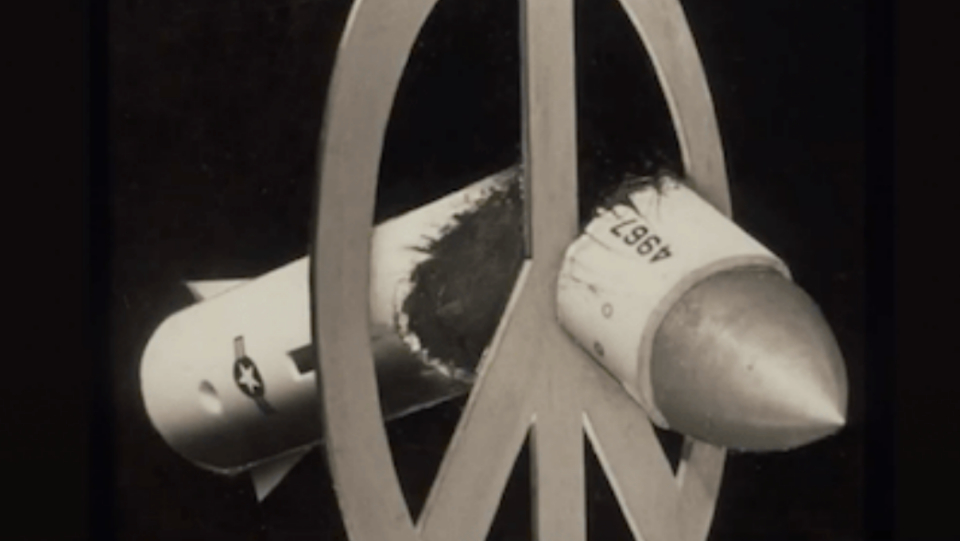
LIVERMORE, Calif.—For decades, peace activists have gathered outside the West Gate of Lawrence Livermore National Laboratory, one of two locations designing and developing every weapon in the U.S. nuclear arsenal, to commemorate the anniversaries of the U.S. atomic bombings of Hiroshima and Nagasaki on Aug. 6 and 9, 1945—to date the only use of nuclear weapons in war—and to call for abolishing all nuclear weapons.
This year’s observance was virtual, as it has been in COVID times, and was filmed at the lab’s gate and at far-flung locations. Highlighted are new dangers emerging during Russia’s war on Ukraine, including weaponization of nuclear power facilities, and the overall environmental threats posed by nuclear power amid the intensifying climate crisis.
The film, Making the Unthinkable Impossible: A Virtual Rally and Action for Nuclear Disarmament, brings together leading peace and anti-nuclear weapons activists with climate justice advocates, community leaders, and musicians, all joining in the call for immediate abolition of nuclear weapons.

As she stood outside the lab’s West Gate, Marylia Kelley, executive director of Tri-Valley Communities Against a Radioactive Environment, or Tri-Valley CAREs, which monitors nuclear weapons and related environmental cleanup activities with a special focus on Livermore Lab, highlighted “spiraling” U.S. nuclear weapons spending as 2023 military budget proposals work their way through Congress. She noted that the House Armed Services Committee recently proposed to add $37 billion to President Joe Biden’s initial request for an already unprecedented $813 billion in overall military spending.
“Livermore Lab is where that funding turns into dangerous proliferation and provocative new nuclear weapons” to be produced elsewhere in the U.S. nuclear weapons complex, Kelley said, displaying a pie-chart showing the lab as receiving over $2 billion, or more than 88% of its funding, for nuclear weapons activities.
“With the horrible war in Ukraine, and Russia’s nuclear saber-rattling,” she said, “the U.S. nuclear budget throws fuel on the fire of a potential nuclear war.”
Among new warheads Livermore Lab is developing: the W80-4, to arm the Long Range Standoff Weapon, designed to enable a pilot to conduct a sneak attack with a precisely-guided radar-evading nuclear weapon against an unsuspecting target thousands of miles away. On the drawing boards: a smaller version for small attack submarines, which are currently armed only with conventional weapons.
Another new warhead is the W87-1, the first completely new warhead to be designed since the end of the U.S.-USSR Cold War over 30 years ago. The W87-1, designed for a new intercontinental ballistic missile called the Sentinel, is to carry a newly-designed plutonium pit significantly different from anything currently in the U.S. stockpile.
Overall, Kelley said, nuclear modernization is slated to cost the U.S. taxpayer upwards of $2 trillion in the next three decades.
“So when you hear that we as a country can’t afford what’s needed to safeguard us from this pandemic or to get ready for the next pandemic, whatever it might be, just think about $2 trillion over 30 years.”
She also highlighted the health and environmental consequences of the Lab’s nuclear weapons work, with nearly 3,000 former employees or their survivors applying for federal compensation due to on-the-job exposures, and state epidemiological studies showing children born in or moving to Livermore experiencing more cancers than comparable children elsewhere. Soil and groundwater contamination at both the Lab’s main site and its Site 300 Explosive Testing Range near Tracy are high enough that they are on the Environmental Protection Agency’s Superfund list of the country’s most contaminated sites.
Kelley said those who would abolish nuclear weapons “now have a new tool” in the United Nations Treaty on the Prohibition of Nuclear Weapons (TPNW), or “Ban Treaty,” which entered into force last year and by the end of June had been ratified by 65 of the world’s 195 countries and signed by 86.
“The U.S. and the other nuclear weapons states have declared their opposition to this treaty,” she said, “but more and more countries are continuing to ratify it and join its regime. The TPNW truly has the power to change global attitudes and norms. It is part of our task to accelerate positive change by lifting up the TPNW and other opportunities for abolition and shining a light on them.”

The Rev. Nobuaki Hanaoka, a retired Methodist minister who as an eight-month-old baby survived the bombing of Nagasaki, described the deadly consequences of bombs that were tiny by today’s standards but nonetheless had the power to kill a quarter of a million people instantly.
Because his family lived miles outside the city limits, they escaped the immediate blast and heat, but they could not escape the radiation. Hanaoka’s mother died a few years later after a long, agonizing illness; his 18-year-old sister died just months later, and his older brother died young, from premature aging.
“I am fortunate to have survived it so far,” Hanaoka said. “Grateful, I join today with the voices of tens of thousands of Hiroshima and Nagasaki survivors” who plead for complete elimination of nuclear weapons and demand that the U.S. join the nations signing the TPNW and negotiate with Russia for an immediate ceasefire in Ukraine.
Hanaoka then called for a moment of silence and prayer to remember all those who perished at Hiroshima and Nagasaki.
Oleg Bodrov, coordinator of the Northwest Russia Peace movement, spoke from Russia as he recalled that when President Vladimir Putin launched the war in Ukraine in February, over 1.2 million Russian citizens signed petitions against the war, and demonstrations were held in many cities. But within a few weeks, all independent media there were shut down, and new laws impose heavy fines and/or jail time for criticizing the war.
He said Putin’s invasion of Ukraine “was a shock” to millions of Russians, but it “soon became clear that Putin sees the conflict “as a war between Russia and NATO on the territory of the former Russian empire,” adding that “the geopolitical situation has changed radically since the invasion.”
Bodrov highlighted the consequences of Russia’s use of “a new type of nuclear weapons” as it captured Europe’s largest nuclear plant, the Zaporizhzhia Nuclear Power Plant, now run by Ukrainian specialists under control of the Russian military.
“Destroying such a nuclear power plant, even with non-nuclear weapons, means detonation of dirty atomic bombs,” he said. “Plutonium, with a half-life of 24,000 years, and other radionuclides can contaminate many thousands of square kilometers in Europe. The Zhaporizhzhia Nuclear Power Plant has effectively come a Russian military base that cannot be attacked because of the dangers of its destruction.”
Calling the people of the United States, Ukraine, Russia, and other countries “neighbors on our common planet, Earth,” Bodrov declared, “Let us hold hands and act together for the health of our living planet!”
Continuing the probe of nuclear power’s relation to war, Mari Inoue, co-founder of the Manhattan Project for a Nuclear-Free World, said while she greatly welcomes the Ban Treaty and its explicit recognition of the disproportionate effect nuclear weapons activity has on indigenous people, the document’s preamble specifically upholds nuclear energy activities.
Saying nuclear power is “deeply rooted in systemic racism and nuclear colonialism that continues to disproportionately impact marginalized communities, Inoue said she was surprised that at the meeting of states-parties to the treaty in June, over a dozen countries from the Global South expressed their support for nuclear power.
“We tend to debate a nuclear war posed by nuclear weapons, but nuclear power plants and storage sites of highly radioactive spent fuel are pre-deployed weapons that are all vulnerable to catastrophic nuclear disasters,” Inoue said. “We also have to stop creating more radioactive waste, by shutting down nuclear power plants and nuclear facilities, because nuclear cannot coexist with humanity.”
Bringing all the elements together was Tova Fuller, M.D., Ph.D., board vice president at San Francisco-Bay Area Physicians for Social Responsibility and clinical assistant professor in the University of California, San Francisco’s Department of Psychiatry.
The climate crisis “is a threat-multiplier, a conflict multiplier,” she said, pointing to the role an extreme drought in Syria played in forcing the migration of a million and a half people from rural to urban areas, in turn contributing to a violent uprising that eventually led to intervention by two nuclear-weapon states, the U.S. and Russia.
“Wars and militaries are the world’s single largest polluters,” Fuller said, but the U.S. is spending 28 times as much on traditional military security as it does on climate security. “How many nuclear weapons do we need for deterrence, if 200 alone can cause nuclear winter and famine?”
Citing recent generations’ focus on the climate crisis, Fuller said it is “urgent to fully comprehend the parallel existential danger posed by nuclear weapons that could cause an even more immediate end to human history.” She also cited the slower planetary contamination exemplified by U.S. nuclear testing in the Marshall Islands from 1946-58 and transporting the resulting radioactive debris to San Francisco’s Hunters Point, “to poison another colonized community.”
Fuller emphasized the intersectionality of those issues. Minorities, children and women are most affected by both, while the exorbitant spending on nuclear and conventional weapons could go to education, healthcare, a Green New Deal – all elements in a just transition to a post-carbon future.

“In this regard, the very premise and practice of the Poor People’s Campaign is illustrative of pulling together the intersectional threads of what most people really care about, certainly when measured by the needs of over 140 million poor in our own country,” she said, “let alone the billions of our species similarly ground down and left behind on the rest of our imperiled planet.”
In a conversation Aug. 6, after the film’s initial screening, Fuller returned to the issue of fully engaging younger activists in the struggle to end nuclear weapons. She told of calculating at one point that the money the U.S. spends on nuclear weapons could have paid for vaccinating the entire world against COVID during the start of the pandemic: “It was astounding to think we could have just ended the pandemic.”
Fuller cited campaigns including #Demand Access, being developed by PSR to work at the intersection of nuclear weapons and social justice issues from a health perspective, as well as Physicians for a National Health Program and the Student National Medical Association, as resonating with younger physicians and medical students.
“I find that when I talk with my med students and residents, the best way to get their interest piqued is to ask them, ‘If you had billions of dollars nationally—what would your priority be?’ And then I tell them what our military budget is, and they just get shocked, and say, ‘You could do that? Do you think we need a nuclear weapon?’”
The tie-in, Fuller said, “is really the money.”
Also featured in the film are Pentagon Papers whistleblower and former Defense Department consultant Daniel Ellsberg, and Sara Shor, organizing director at GreenFaith.
Offering a land blessing at Livermore Lab’s West Gate was Patricia St. Onge, a Six Nations/Haudenosaune and Quebecois, and partner in Seven Generations Consulting. MC for the film was Andrew Kodama, executive director of the Mt. Diablo Peace and Justice Center in Contra Costa County. Music was provided by composer and performer Benjamin Mertz, and by the singer-songwriter duo Pat Humphries and Sandy O, who perform as Emma’s Revolution.










